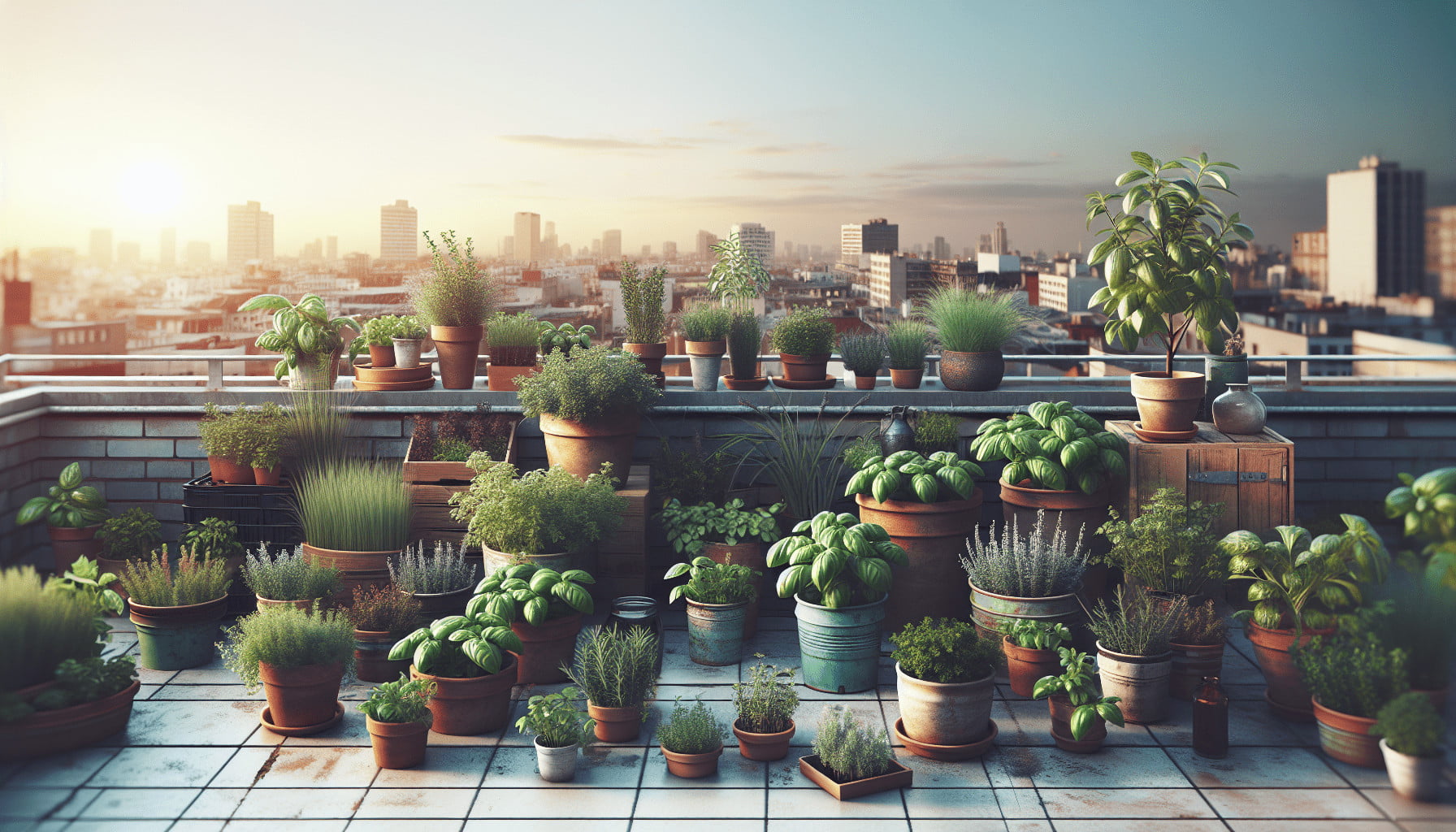If you’re looking to start a rooftop container garden, you’ll want to know the top herbs to grow in this unique and fulfilling gardening style. With limited space, it’s essential to choose herbs that are not only hardy and versatile but also provide maximum flavor and aroma for your culinary creations. Whether you’re a seasoned gardener or a beginner, this article will guide you through the top herbs that thrive in rooftop container gardens, allowing you to enjoy a vibrant and fragrant garden right at your fingertips. From basil and mint to rosemary and thyme, discover the herbs that will take your rooftop garden to new heights.
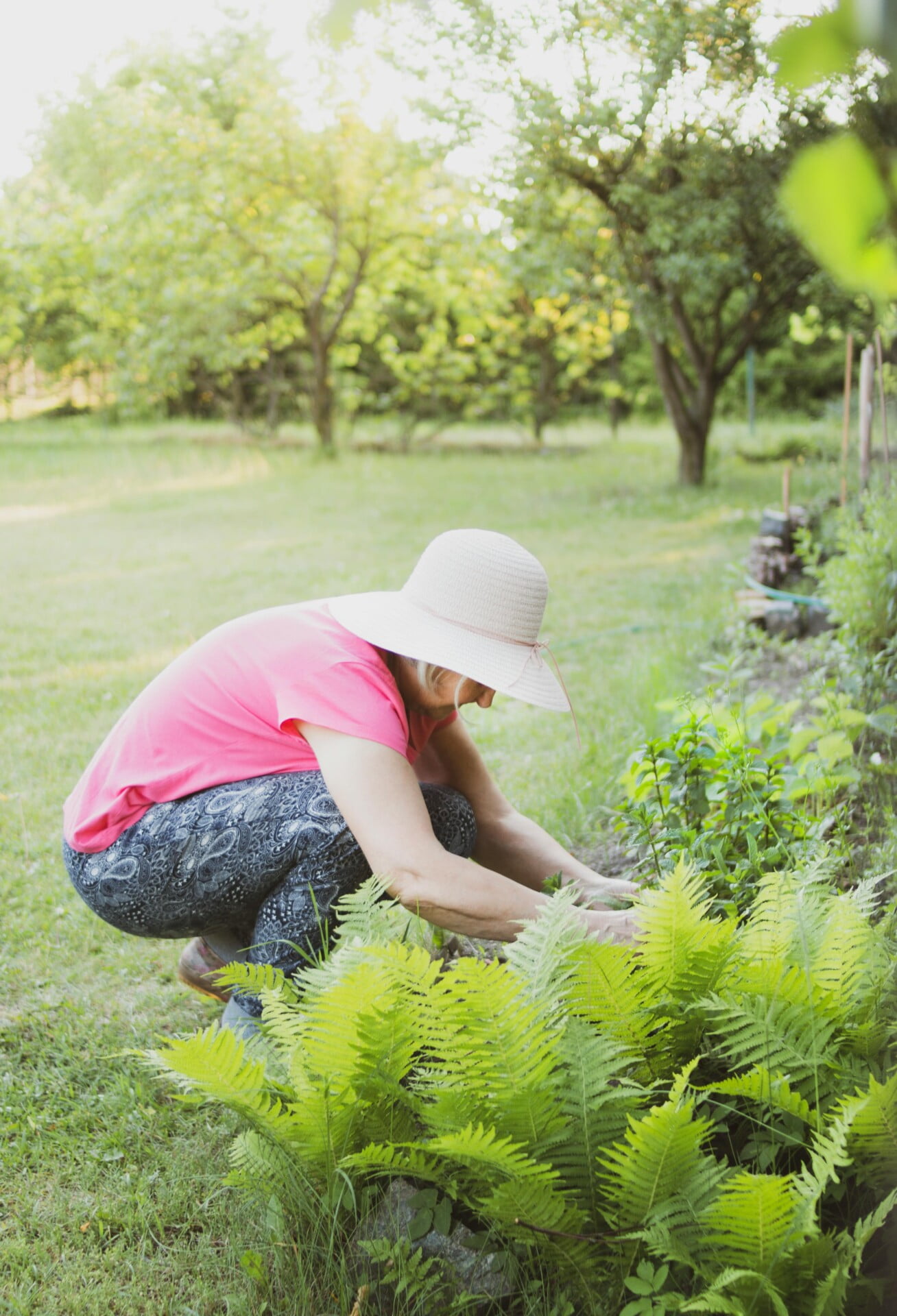
Basil
Basil is a popular herb that is commonly used in cooking and is known for its strong aroma and flavor. There are several varieties of basil that you can choose from, each with its own unique characteristics. The most common varieties include sweet basil, lemon basil, and Thai basil.
When it comes to growing basil, it is relatively easy to care for and can be grown in containers on your rooftop. Basil prefers warm weather and requires at least six to eight hours of direct sunlight each day. It is important to choose a well-draining potting mix and water the plant regularly, keeping the soil evenly moist but not waterlogged.
To harvest basil, simply snip off the leaves with a pair of clean scissors or pinch them off with your fingers. You can use fresh basil in a variety of dishes, such as pasta sauces, salads, and even cocktails. If you have an abundance of basil, you can also dry the leaves and store them in an airtight container for later use.
Cilantro
Cilantro, also known as coriander, is an herb that is commonly used in Mexican, Indian, and Asian cuisines. It has a distinctive flavor that adds a fresh and citrusy taste to dishes. When it comes to growing cilantro, it is important to note that it has a relatively short lifespan and tends to bolt or go to seed quickly.
To grow cilantro, choose a container that is at least 6 inches deep and fill it with a well-draining potting mix. Cilantro prefers cooler temperatures and can tolerate some shade. It is important to keep the soil evenly moist and avoid overwatering, as this can cause the plant to rot.
When harvesting cilantro, you can snip off the leaves as needed or cut the plant back to encourage more growth. Cilantro can be used in a variety of dishes, such as salsas, guacamole, curries, and soups. You can also use the stems and roots of cilantro to flavor stocks and broths.
Mint
Mint is a versatile herb with a refreshing and cooling flavor. It is commonly used in beverages, desserts, and even savory dishes. There are several types of mint that you can choose from, including spearmint, peppermint, and chocolate mint, each with its own unique flavor profile.
Growing mint in containers on your rooftop is a great way to enjoy its fresh flavor all summer long. Mint requires a lot of sunlight, so it is best to place the container in a sunny spot. It is important to choose a large container with good drainage to prevent the roots from becoming waterlogged.
To harvest mint, simply snip off the leaves with a pair of clean scissors or pinch them off with your fingers. You can use fresh mint in a variety of drinks, such as mojitos, iced tea, and lemonade. Mint can also be used in salads, sauces, and desserts, or even as a garnish for dishes.
Parsley
Parsley is an herb that is commonly used as a garnish to add a fresh and vibrant touch to dishes. There are two main types of parsley: curly parsley and flat-leaf parsley. Flat-leaf parsley is favored by many chefs for its stronger flavor, while curly parsley is often used for its decorative appeal.
Growing parsley from seed is relatively easy and can be done in containers on your rooftop. Parsley prefers well-draining soil and requires at least six hours of direct sunlight each day. It is important to water the plant regularly and keep the soil evenly moist.
To harvest parsley, simply snip off the leaves as needed. You can use fresh parsley in a variety of dishes, such as salads, soups, and marinades. Parsley can also be used as a garnish for pasta dishes, roasted vegetables, and grilled meats. If you have an abundance of parsley, you can also dry the leaves and store them for later use.
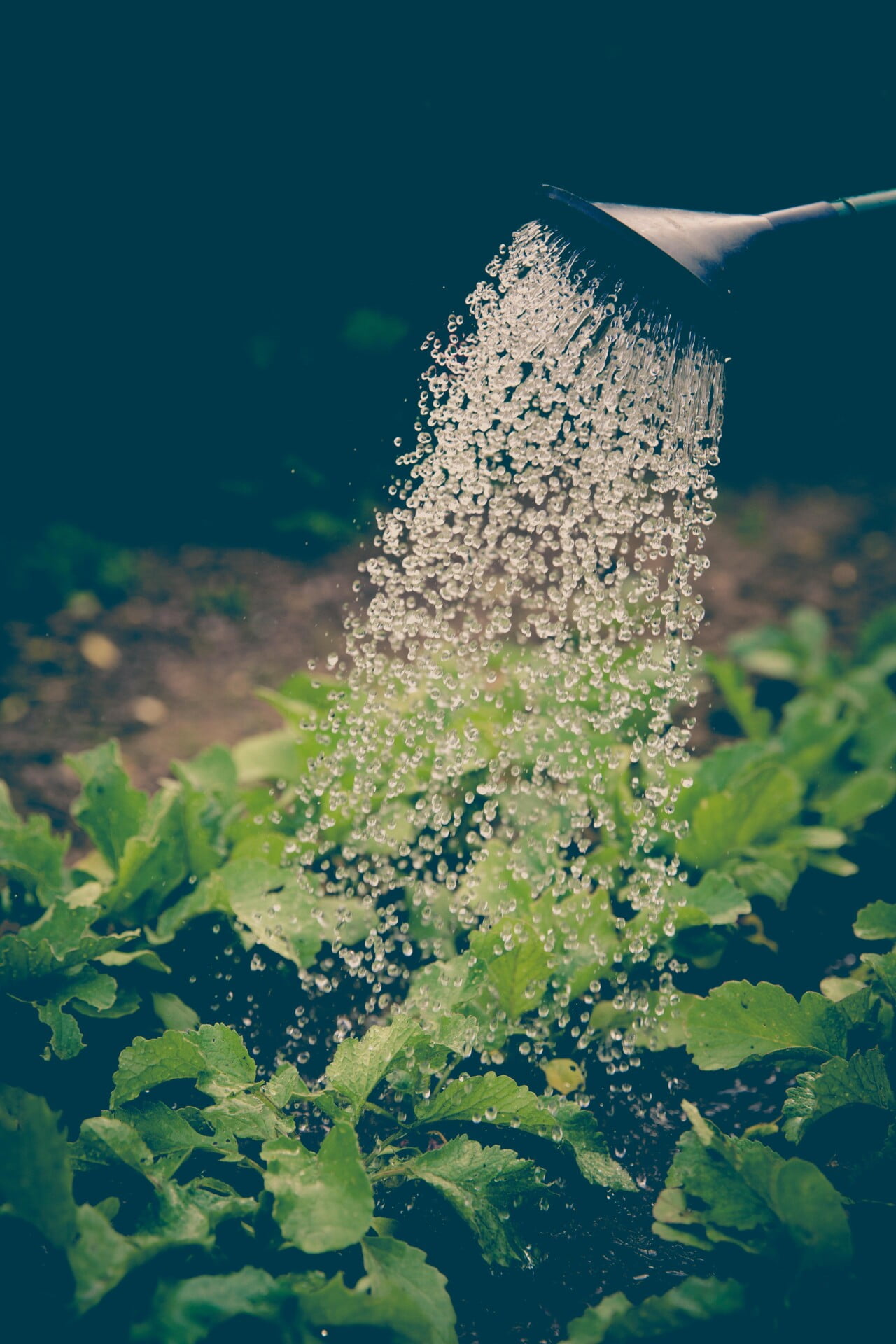
Rosemary
Rosemary is a fragrant and flavorful herb that is commonly used in Mediterranean cuisine. It has needle-like leaves and a woody stem, and its strong aroma adds a savory touch to dishes. Growing rosemary in containers on your rooftop is a great way to have fresh herbs year-round.
When planting rosemary in containers, choose a pot that is at least 12 inches deep to accommodate the plant’s root system. Rosemary prefers well-draining soil and requires at least six hours of direct sunlight each day. It is important to water the plant regularly but allow the soil to dry out slightly between waterings.
To harvest rosemary, simply snip off the sprigs with a pair of clean scissors or pinch them off with your fingers. You can use fresh rosemary in a variety of dishes, such as roasted meats, vegetables, soups, and sauces. Rosemary can also be used to infuse oils, vinegars, and even cocktails.
Thyme
Thyme is a versatile herb that is commonly used in Mediterranean, Italian, and French cuisines. It has small, aromatic leaves and a subtle, earthy flavor that pairs well with a variety of dishes. There are several types of thyme to choose from, including lemon thyme, English thyme, and French thyme.
Growing thyme in containers on your rooftop is relatively easy and requires minimal maintenance. Thyme prefers well-draining soil and requires at least six hours of direct sunlight each day. It is important to water the plant regularly, but avoid overwatering, as thyme is susceptible to root rot.
To harvest thyme, simply snip off the sprigs with a pair of clean scissors or pinch off the leaves with your fingers. You can use fresh thyme in a variety of dishes, such as roasted meats, stews, soups, and sauces. Thyme can also be used to flavor marinades, dressings, and even infused honey.
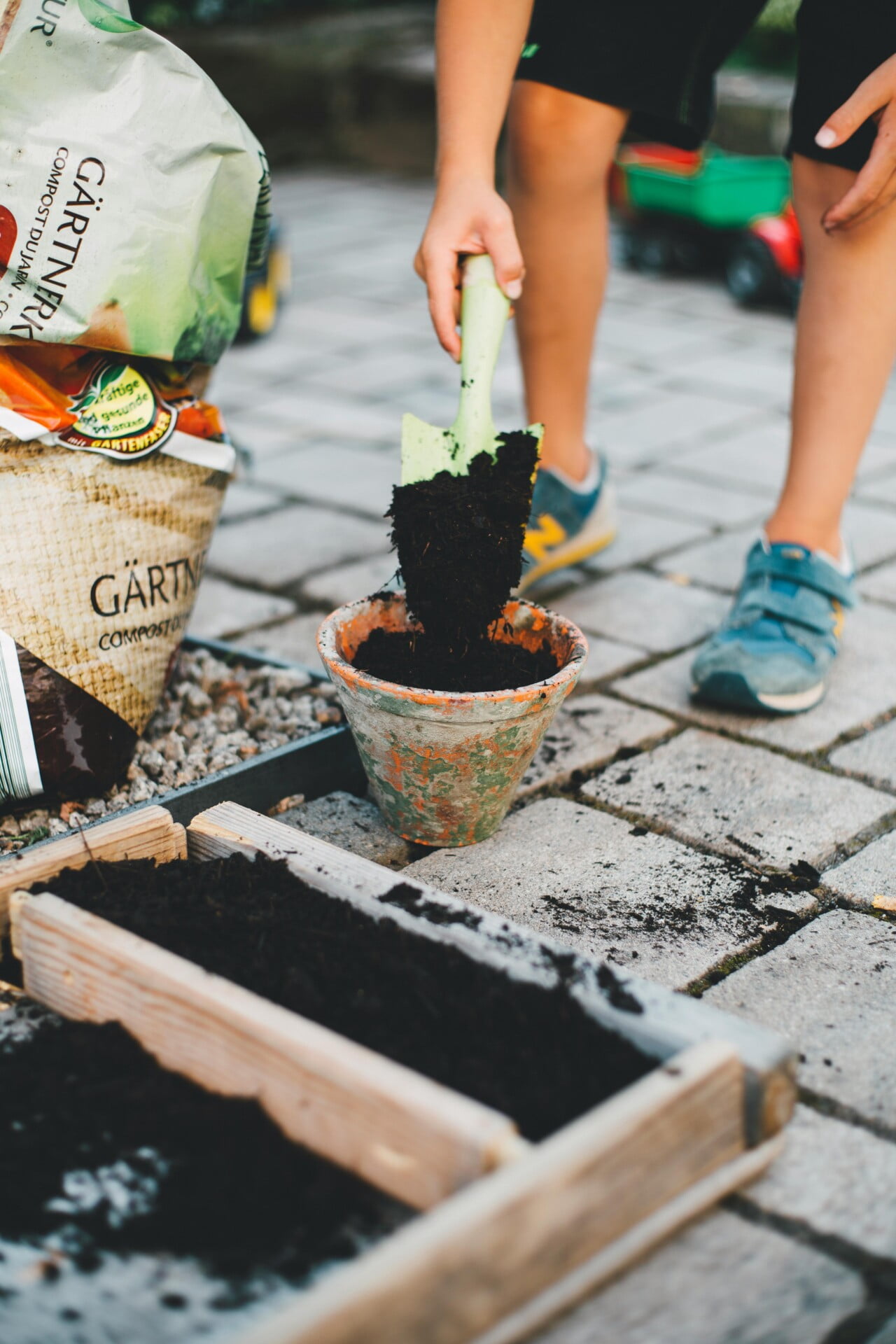
Sage
Sage is an herb that is commonly used in Mediterranean and Italian cuisines. It has aromatic leaves with a slightly bitter and savory flavor. Growing sage in containers on your rooftop is a great way to have access to this versatile herb all year round.
When planting sage in containers, choose a pot that is at least 8 inches deep to accommodate the plant’s root system. Sage prefers well-draining soil and requires at least six hours of direct sunlight each day. It is important to water the plant regularly, but allow the soil to dry out slightly between waterings.
To harvest sage, simply snip off the leaves with a pair of clean scissors or pinch them off with your fingers. You can use fresh sage in a variety of dishes, such as roasted meats, poultry, stuffing, and sauces. Sage can also be used to flavor oils, vinegars, and even cocktails.
Oregano
Oregano is a flavorful herb that is commonly used in Mediterranean and Italian cuisines. It has small, aromatic leaves and a robust flavor that adds a savory touch to dishes. Growing oregano in containers on your rooftop is a great way to have access to fresh herbs all year round.
When growing oregano in containers, choose a pot that is at least 6 inches deep and provide well-draining soil. Oregano requires at least six hours of direct sunlight each day and thrives in warm temperatures. It is important to water the plant regularly and keep the soil evenly moist.
To harvest oregano, simply snip off the stems with a pair of clean scissors or pinch off the leaves with your fingers. You can use fresh oregano in a variety of dishes, such as pasta sauces, pizzas, roasted vegetables, and marinades. Oregano can also be dried and stored for later use.
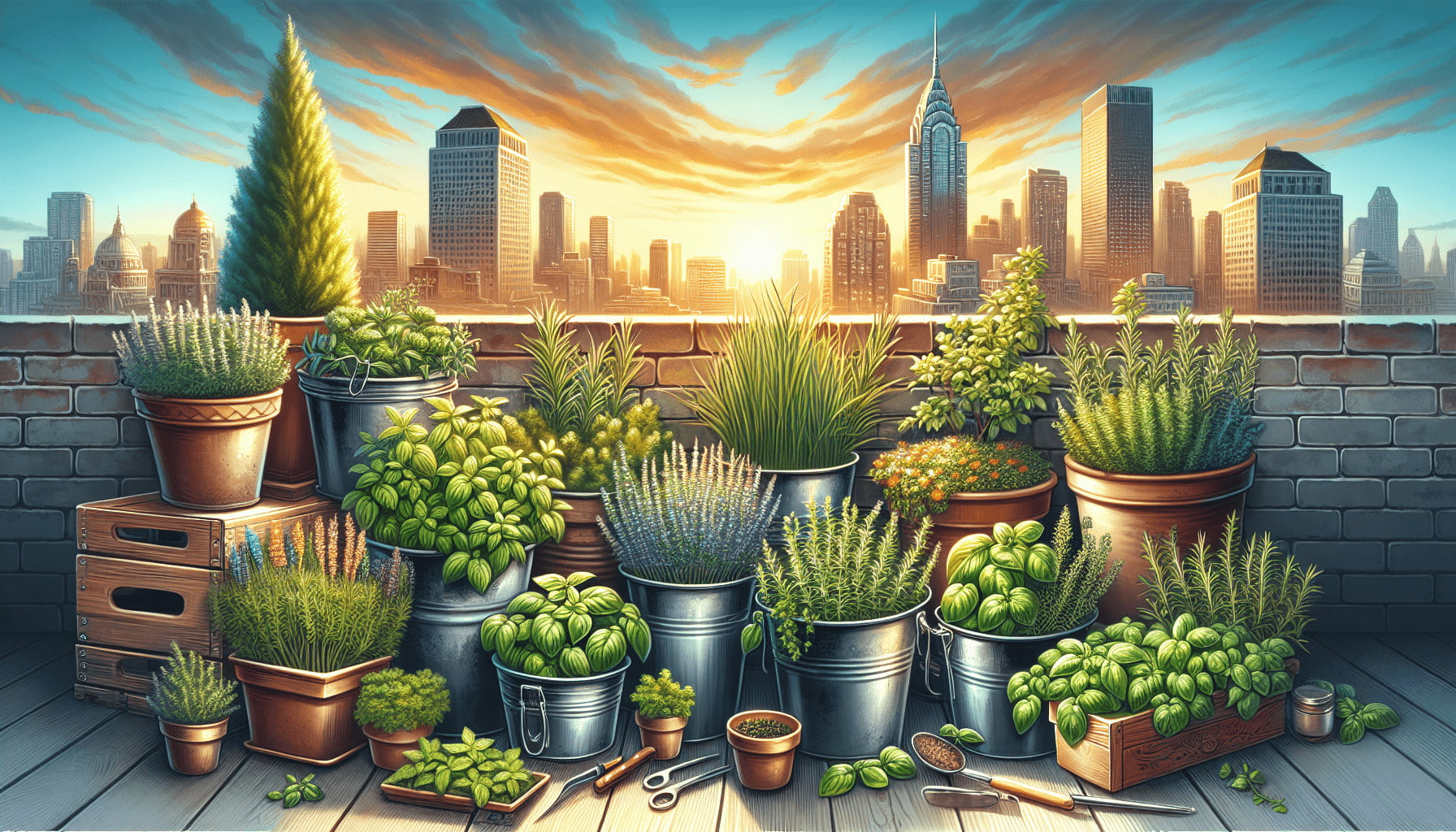
Chives
Chives are a member of the onion family and are commonly used as an herb to add a mild onion flavor to dishes. They have thin, grass-like leaves and edible purple flowers. Growing chives in containers on your rooftop is relatively easy and requires minimal maintenance.
When planting chives in containers, choose a pot that is at least 6 inches deep and provide well-draining soil. Chives prefer full sun but can tolerate some shade. It is important to water the plant regularly, but allow the soil to dry out slightly between waterings.
To harvest chives, simply snip off the leaves with a pair of clean scissors or pinch them off with your fingers. You can use fresh chives in a variety of dishes, such as omelets, salads, soups, and creamy dips. Chives can also be used as a garnish for baked potatoes, grilled meats, and seafood dishes.
Lemon Balm
Lemon balm is an herb that has a fresh and lemony flavor. It is commonly used in teas, desserts, and even savory dishes. Growing lemon balm in containers on your rooftop is relatively easy and can bring a delightful fragrance to your rooftop garden.
When growing lemon balm in containers, choose a pot that is at least 6 inches deep and provide well-draining soil. Lemon balm prefers full sun to partial shade. It is important to water the plant regularly and keep the soil evenly moist.
To harvest lemon balm, simply snip off the leaves with a pair of clean scissors or pinch them off with your fingers. You can use fresh lemon balm in a variety of dishes, such as fruit salads, cocktails, sauces, and infused oils. Lemon balm can also be used to make a refreshing tea or as a garnish for desserts.
